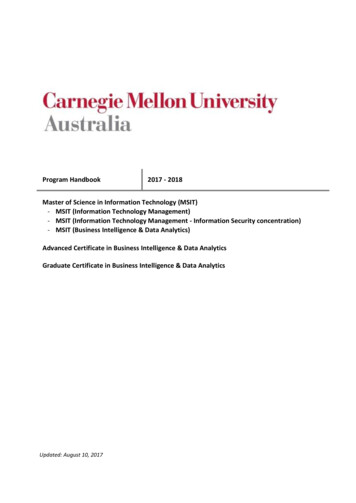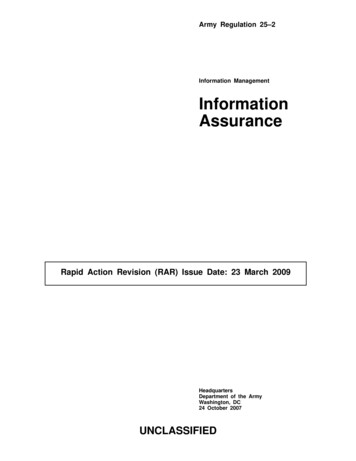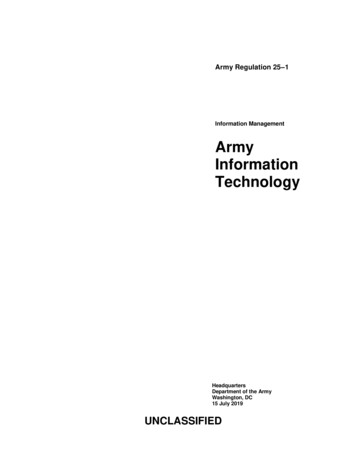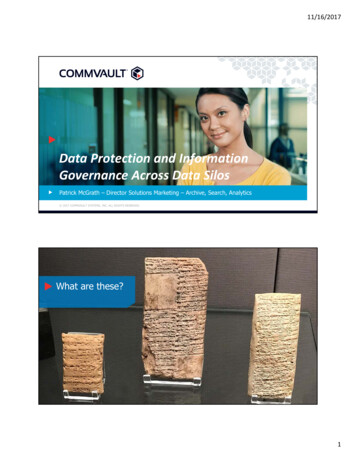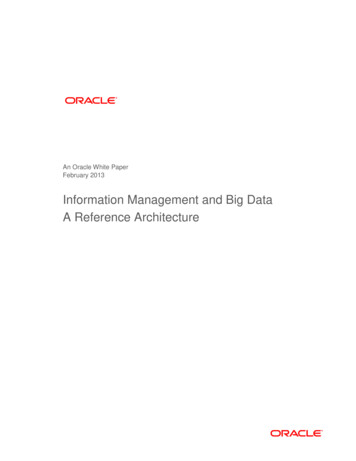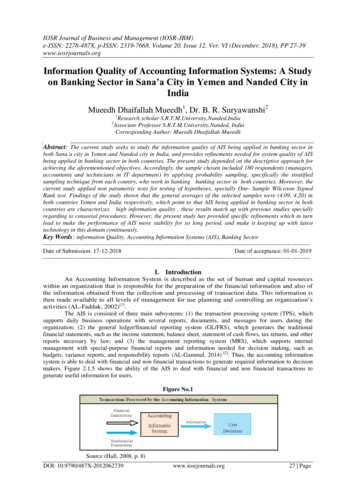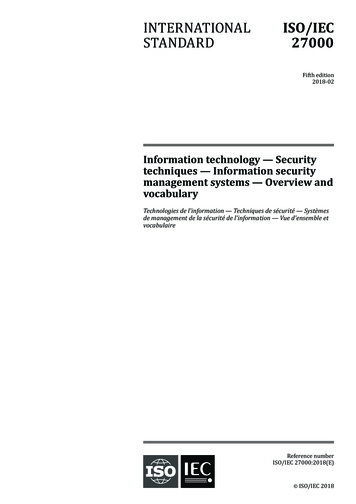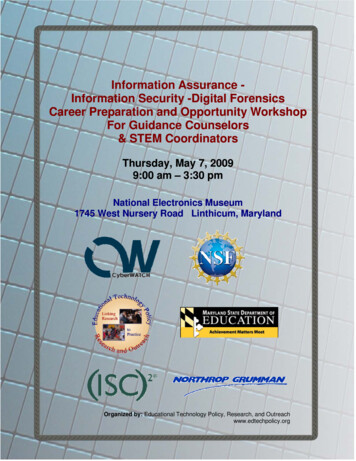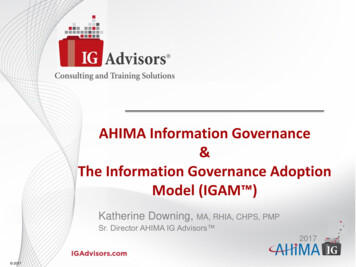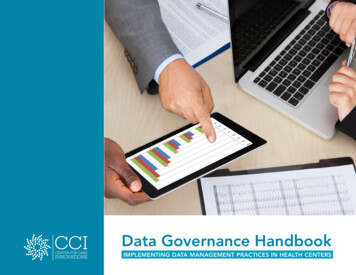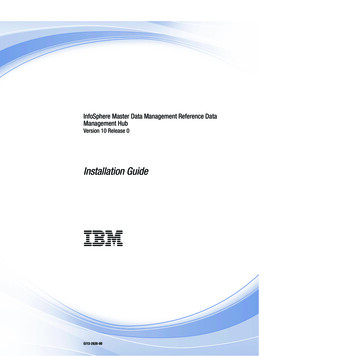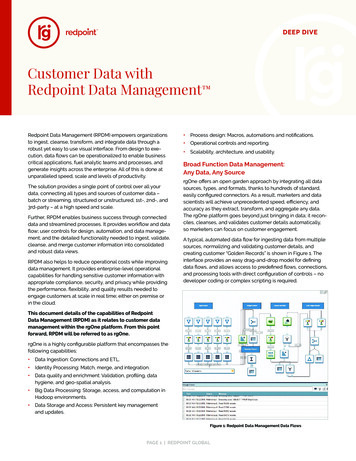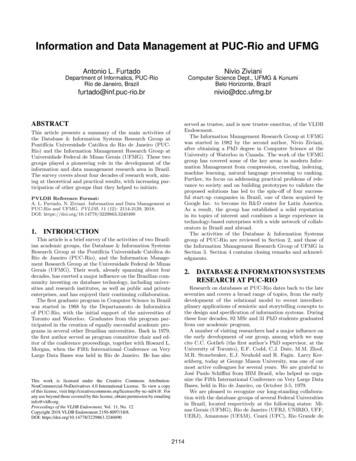
Transcription
Information and Data Management at PUC-Rio and UFMGAntonio L. FurtadoNivio ZivianiDepartment of Informatics, PUC-RioRio de Janeiro, BrazilComputer Science Dept., UFMG & KunumiBelo Horizonte, ACTThis article presents a summary of the main activities ofthe Database & Information Systems Research Group atPontifı́cia Universidade Católica do Rio de Janeiro (PUCRio) and the Information Management Research Group atUniversidade Federal de Minas Gerais (UFMG). These twogroups played a pioneering role in the development of theinformation and data management research area in Brazil.The survey covers about four decades of research work, aiming at theoretical and practical results, with increasing participation of other groups that they helped to initiate.PVLDB Reference Format:A. L. Furtado, N. Ziviani. Information and Data Management atPUC-Rio and UFMG. PVLDB, 11 (12): 2114-2129, 2018.DOI: TIONThis article is a brief survey of the activities of two Brazilian academic groups, the Database & Information SystemsResearch Group at the Pontifı́cia Universidade Católica doRio de Janeiro (PUC-Rio), and the Information Management Research Group at the Universidade Federal de MinasGerais (UFMG). Their work, already spanning about fourdecades, has exerted a major influence on the Brazilian community investing on database technology, including universities and research institutes, as well as public and privateenterprises, and has enjoyed their continuing collaboration.The first graduate program in Computer Science in Brazilwas started in 1968 by the Departamento de Informáticaof PUC-Rio, with the initial support of the universities ofToronto and Waterloo. Graduates from this program participated in the creation of equally successful academic programs in several other Brazilian universities. Back in 1979,the first author served as program committee chair and editor of the conference proceedings, together with Howard L.Morgan, when the Fifth International Conference on VeryLarge Data Bases was held in Rio de Janeiro. He has alsoThis work is licensed under the Creative Commons AttributionNonCommercial-NoDerivatives 4.0 International License. To view a copyof this license, visit http://creativecommons.org/licenses/by-nc-nd/4.0/. Forany use beyond those covered by this license, obtain permission by emailinginfo@vldb.org.Proceedings of the VLDB Endowment, Vol. 11, No. 12Copyright 2018 VLDB Endowment 2150-8097/18/8.DOI: https://doi.org/10.14778/3229863.3240490served as trustee, and is now trustee emeritus, of the VLDBEndowment.The Information Management Research Group at UFMGwas started in 1982 by the second author, Nivio Ziviani,after obtaining a PhD degree in Computer Science at theUniversity of Waterloo in Canada. The work of the UFMGgroup has covered some of the key areas in modern Information Management from compression, crawling, indexing,machine learning, natural language processing to ranking.Further, its focus on addressing practical problems of relevance to society and on building prototypes to validate theproposed solutions has led to the spin-off of four successful start-up companies in Brazil, one of them acquired byGoogle Inc. to become its R&D center for Latin America.As a result, the group has established a solid reputationin its topics of interest and combines a large experience intechnology-based enterprises with a wide network of collaborators in Brazil and abroad.The activities of the Database & Information Systemsgroup of PUC-Rio are reviewed in Section 2, and those ofthe Information Management Research Group of UFMG inSection 3. Section 4 contains closing remarks and acknowledgments.2.DATABASE & INFORMATION SYSTEMSRESEARCH AT PUC-RIOResearch on databases at PUC-Rio dates back to the lateseventies and covers a broad range of topics, from the earlydevelopment of the relational model to recent interdisciplinary applications of semiotic and storytelling concepts tothe design and specification of information systems. Duringthese four decades, 92 MSc and 31 PhD students graduatedfrom our academic program.A number of visiting researchers had a major influence onthe early development of our group, among which we maycite C.C. Gotlieb (the first author’s PhD supervisor, at theUniversity of Toronto), E.F. Codd, C.J. Date, M.M. Zloof,M.R. Stonebraker, E.J. Neuhold and R. Fagin. Larry Kerschberg, today at George Mason University, was one of ourmost active colleagues for several years. We are grateful toJosé Paulo Schiffini from IBM Brasil, who helped us organize the Fifth International Conference on Very Large DataBases, held in Rio de Janeiro, on October 3-5, 1979.We are pleased to recognize our long-standing collaboration with the database groups of several Federal Universitiesin Brazil, located respectively at the following states: Minas Gerais (UFMG), Rio de Janeiro (UFRJ, UNIRIO, UFF,UERJ), Amazonas (UFAM), Ceará (UFC), Rio Grande do2114
Sul (UFRGS, UFPel, UFSM), and São Paulo (UNICAMP).In special, the Database Group at the Universidade Federal do Rio Grande do Sul (UFRGS) was initiated by ClésioS. dos Santos and José M. V. de Castilho, who worked towards their PhD degree under the supervision of the firstauthor. They would soon distinguish themselves, the former for creative leadership, and both of them for outstanding teaching and research performance. Other collaboratorsinclude research institutes such as the Instituto Nacional dePesquisa Espacial (INPE), Instituto Brasileiro de Geografiae Estatı́stica (IBGE) and the Laboratório Nacional de Computação Cientı́fica (LNCC). Among collaborating businesscorporations, we should cite Petrobras, IBM Brasil and DellEMC. Finally, within our own department, the multimediagroup has significantly participated in our projects.Besides the research papers to be discussed in this section,the Database & Information Systems Group of PUC-Riopublished a number of books, among which should be mentioned [32], [37] and [75]. As textbooks for undergraduateand introductory graduate courses, the group has startedlong ago with [76], describing the early hierarchic, networkand relational data models, as well as file organizations andthe then available database management systems.In what follows we shall review some of the major contributions of our group, from the perspective of the first author.The contributions are organized according to the data modelor to the underlying applications that they are based on: (1)the relational model; (2) the entity-relationship model; (3)several formalisms, including algebraic specification; (4) aplan generation and recognition paradigm; (5) methods topromote cooperative behavior; (6) the problem of publishing databases on the Web; (7) a semiotic approach to theconceptual specification of information systems; (8) addingstory-bases to data-bases. The last four topics have receivedspecial attention.2.12.1.1Early YearsContributions to the Relational ModelContributions to the development of the relational modelcan be traced back to the 1977 SIGMOD Conference, wherean algebra of quotient relations was proposed [74]. In a second early paper [62], the relational model was studied fromthree interdependent viewpoints. Relational databases werefirst modeled by directed hypergraphs, a concept derived in astraightforward way from Berge’s hypergraph theory. Then,the abstract directed hypergraphs were interpreted using alinguistic model. Finally, the hypergraphs were representedwith the help of relations and additional structures. Normalization was then discussed in the context of the threeapproaches. The design of relational databases based onfunctional dependencies (FDs) and inclusion dependencies(INDs) was addressed in [39]. Motivated by the above formal analysis, an investigation was undertaken on how toefficiently enforce inclusion dependencies and referential integrity [42, 43]. An analysis of the integrity constraints defined in the SQL ISO standard in the light of the entityrelationship model was also carried out [95]. Departing fromthe tradition of data dependencies, a database descriptionframework [46] was introduced that accounts for both staticconstraints and transition constraints.The view update and the view integration problems wereaddressed in several papers. The effects of a wide range ofupdate operations on relational views were investigated [77]to identify which operations must be prohibited in orderto assure harmonious interactions among database users,and which operations could be allowed, even though thestructure of the view may substantially differ from the actual structure of the database. Later on, a survey on theview update problem was published [65], covering the twobasic approaches proposed at that time to solve the problem. The first approach suggested treating views as abstractdatatypes so that the definition of the view included all permissible view updates, together with their translations. Thesecond approach led to general view update translators andwas based either on an analysis of the conceptual schemadependencies or on the concept of view complement to disambiguate view update translations.2.1.2Contributions to the Entity-Relationship ModelResults about the entity-relationship model were alreadyreported at the 1st ER Conference [126]. A datatype approach to database semantics was considered using the ERmodel as a framework. Later on, a method, also based on abstract datatypes, was proposed for representing a databaseapplication on a simple entity-relationship data model [78]and two constructs that capture and extend the generalization and subset abstractions were proposed [137], togetherwith operations to maintain entity and relationship sets organized according to these constructs. As a result of the investigation on the ER model, an expert software tool, calledCHRIS, was developed to help in the design and rapid prototyping of information systems containing a database component [136].Continuing this line of research, we introduced a declarative way of specifying both the structure and the operationsof an entity-relationship schema [66]. The paper proceededto describe a plan generation algorithm and a method tointroduce the time dimension, whereby the facts that holdat a certain instant can be inferred from the record of theoperations executed. By combining these features, the paper showed how to extend temporal databases so as to coverpast, present and future states (as determined by fixed commitments), as well as to draw plans coupled with time schedules. A second paper [44] defined a design algorithm thataccepts as input an entity-relationship conceptual schemaand generates an optimized relational representation for theschema (optimized in the sense that the number of dependencies of the relational schema is minimized).The question of database redesign was retaken in [131].A mapping strategy proposed earlier [95] was generalizedin [132]. Finally, a survey, included in the Encyclopediaof Database Systems, summarized work on mapping entityrelationship schemas into relational schemas [22].This long tradition of contributions to the ER Conferenceswas recognized through the first author’s invited talk at the28th ER Conference [70] and, years later, when he receivedthe 2014 Peter P. Chen Award [68].2.1.3Formal Specification and ModularizationThe earliest contribution to database design based on algebraic specifications was published in 1981 [125]. The paper proposed a formalism adequate for the specification ofbehavioral properties of data bases. Research then proceeded in three directions: complementary specifications,stepwise refinement and modular design.2115
A methodology was proposed for the systematic derivation of a series of complementary specifications of a databaseapplication [139]. The topic of complementary specificationswas retaken in [45]. Logical, algebraic, programming language, grammatical and denotational formalisms were investigated with respect to their applicability to formal databasespecification. On applying each formalism for the purposethat originally motivated its proposal, the paper showed thatthey all have a fundamental and well-integrated role to playin different parts of the specification process.Stepwise refinement and modularization were addressedin [129]. Modularization was discussed as another dimension in the specification process, orthogonal to stepwise refinement [41]. The modularization discipline incorporatedboth a strategy for enforcing integrity constraints and a tactic for organizing large sets of database structures, integrityconstraints, and operations.2.1.4Plan Generation / Plan RecognitionWe have been working with the conceptual modeling ofinformation systems with a database component, considering their static, dynamic and behavioral aspects. The threeaspects were integrated through the application of a planrecognition / plan-generation paradigm [72]. The static aspect concerns what facts hold at some database state, conveniently described in terms of the entity-relationship model.The dynamic aspect corresponds to events that can producestate transitions. The behavioral aspect refers to the agentsauthorized to cause events by performing the operations.As a further development, we have started to look atagent profiles involving three kinds of personality factors,from which a decision-making process could operate: drivesfor the emergence of goals from situations, attitudes for thechoice of plans to achieve the preferred goal, and emotions todecide whether or not to commit to the execution of the chosen plan, depending on the expected emotional gain whenpassing from the current to the target state [17]. And, asan inducement to revise individual decisions, we includedcompetition and collaboration interferences, as prescribed formulti-agent contexts [141].In order to make our conceptual specifications execu
these four decades, 92 MSc and 31 PhD students graduated from our academic program. A number of visiting researchers had a major in uence on the early development of our group, among which we may cite C.C. Gotlieb (the rst author’s PhD supervisor, at the University of
